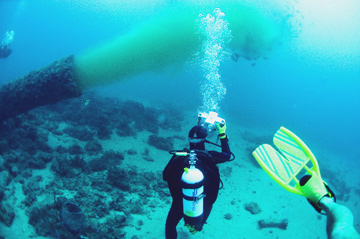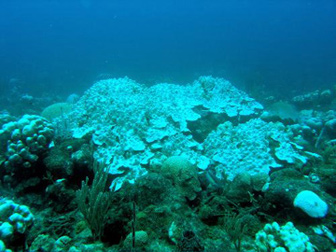Humans responsible for dying coral reefs in the Caribbean
Human activity is killing coral reefs in the Caribbean
January 8, 2008
Direct correlation found between human population and coral mortality in the Caribbean.
A wide and thorough study of the Caribbean’s coral reefs—including 322 sites in 13 countries—has shown that the main indicator of coral destruction in the Caribbean is the proximity of human populations: the larger the population the greater the deterioration of the reefs. Contributing factors are numerous, but the study showed that coastal development causes the most damage to coral reefs and fish populations, because of increased sewage and fishing pressure; while proximity to agriculture results in macroalgae due to runoff of agricultural chemicals.

Terrestrial runoff. Photo by Mark Defeo of Marine Photobank |
Additionally, rising temperatures from climate change have contributed to coral reef morality and are considered a significant threat to reef systems. The direct correlation between human population size and coral reef mortality disproves the long held belief that coral reefs experience the same deterioration independent of human presence. Currently, 121 million people live along the Caribbean coasts—four times the population of Canada. Dr. Camilo Mora, the author of the report, warns that “the continuing degradation of coral reefs may be soon beyond repair, if threats are not identified and rapidly controlled. This new study moves from the traditional localized study of threats to a region-wide scale, while simultaneously analyzing contrasting socioeconomic and environmental variables.”
 
Sewage and Macroalgae-dominated reef. Photos by Steve Spring of Marine Photobank |
Coral reefs’ complex ecology and network of interdependence—much like rainforests—makes them particularly vulnerable to widespread human pressures. “On one hand, coral reefs are maintained due to intricate ecological interactions among groups of organisms. For instance, predators prey upon herbivorous, herbivores graze on macroalgae, and macroalgae and corals interact for their use of hard substrata. Given the intensity of these interactions the effects of a threat in anyone group may escalate to the entire ecosystem. On the other hand, the array of human stressors arising from changes in land use, exploitation of natural resources and increases in ocean temperature (and perhaps acidification) due to an increasing demand for energy, are significantly affecting all major groups of coral reef organisms.” The main protections already in place for coral reefs, called MPAs (Marine Protected Areas) have not done little to help reefs, according to the study. While MPAs have brought about recovery in fish populations, they have done little to address other threats to reefs, including agricultural runoff, sewage, and warming in the oceans. Underlying all theses threats to coral reefs is the expanding human population says Dr. Mora: “the expected increase of the world’s human population from 6 billion today to 9 billion for the year 2050 suggests that coral reefs are likely to witness a significant ecological crisis in the coming half century if effective conservation strategies, including policies on population planning, are not implemented soon. Dr. Mora sees this situation as proof for the need of what he calls a ‘holistic’ solution to human impact.

Overfishing. Photo by Stephen McGowan of Marine Photobank Warming-induced bleaching. Photo by Tyler Smith of Marine Photobank |
Conservation of coral reefs is very possible, depending on the world’s will. According to Dr. Mora the demise of coral reefs jeopardizes more than the reefs themselves, “over 4 billion dollars in services worth from fisheries, tourism and coastal protection”. The future of these services, as well as the future of all life reliant on the reefs, now depends on Caribbean nations’ willingness to doggedly address the issues that cause reef deterioration. The report suggests a comprehensive approach “including the use of enforced no-take MPAs… complemented with strategies to regulate the effects of land use and international commitment to reduce the emission of greenhouse gases, and finally the implementation of strategies to reduce or stabilize the ultimate cause of all these stressors, the world’s human population.”
Coral reefs are often referred to as the rainforests of the sea, and like rainforests their viability is increasingly threatened by humanity. To preserve these vast and marvelous ecosystems, nations must act with far more resolution than they have before. Recently, the UN implemented a program to protect tropical forests (REDD). Perhaps, it is time for nations to create a similar program for the world’s coral reef systems.








